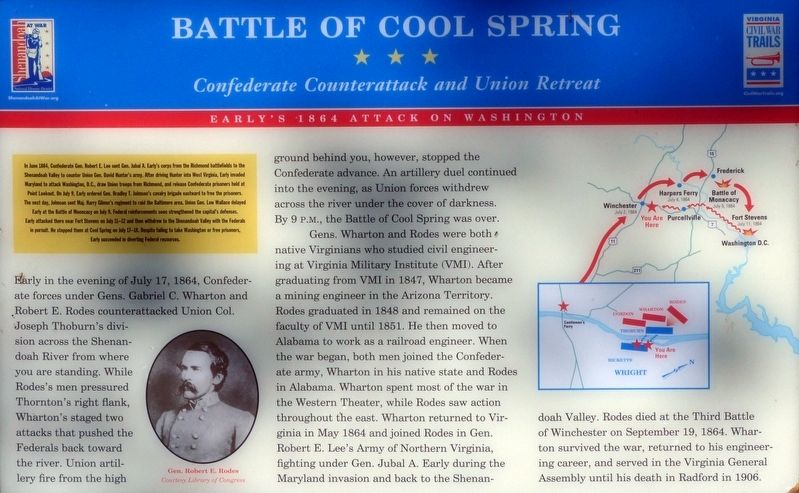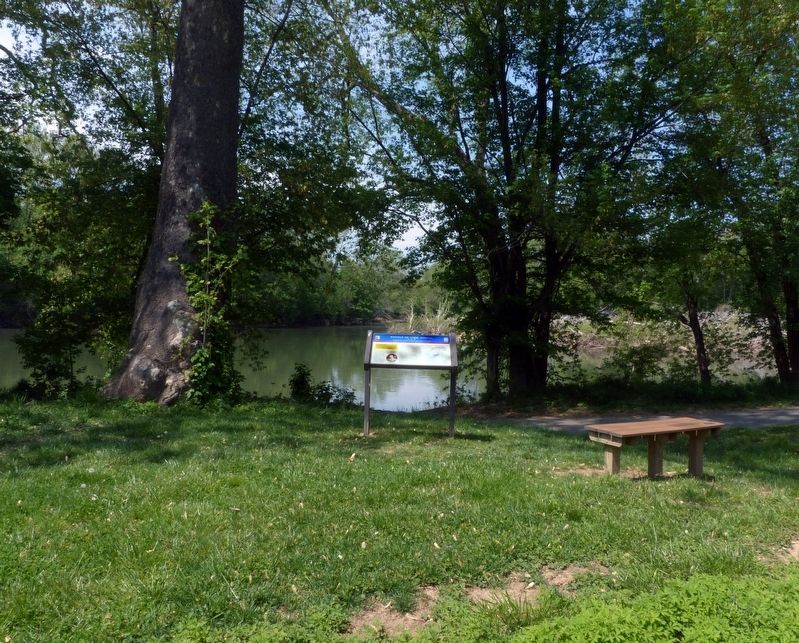Near Longwood in Clarke County, Virginia — The American South (Mid-Atlantic)
Confederate Counterattack and Union Retreat
Battle of Cool Spring
— Early's 1864 Attack on Washington —
Inscription.
In June 1864, Confederate Gen. Robert E. Lee detached Gen. Jubal A. Early's corps from the Richmond battlefields and dispatched it to the Shenandoah Valley to counter Union Gen. David Hunter's army. After driving Hunter into West Virginia, Early launched an incursion through Maryland against Washington, D.C., to draw Union troops from Richmond and to release Confederate prisoners held at Point Lookout. On July 9, Early detached Gen. Bradley T. Johnson's cavalry brigade, including Maj. Harry Gilmor and his cavalry to raid eastward toward Baltimore. Union Gen. Lew Wallace delayed Early at the Battle of Monocacy on July 9, as Federal reinforcements strengthened the capitals defenses. Early probed them briefly on July 11-12 and then withdrew to the Shenandoah Valley, where he stopped the Federal pursuit at Cool Spring on July 17-18.Despite failing to take Washington, Early's invasion succeeded in diverting Federal resources.
Early in the evening of July 17, 1864, Confederate forces under Gens. Gabriel C. Wharton and Robert E. Rodes counterattacked Union Col. Joseph Thoburn's division across the Shenandoah River from where you are standing. While Rodes's men pressured Thornton's right flank, Wharton's staged two attacks that pushed the Federals back toward the river. Union artillery fire from the high ground behind you, however, stopped the Confederate advance. An artillery duel continued into the evening, as Union forces withdrew across the river under the cover of darkness. By 9P.M., the Battle of Cool Spring was over.
Gens. Wharton and Rodes were both native Virginians who studied civil engineering at Virginia Military Institute (VMI). After graduating from VMI in 1847, Wharton became a mining engineer in the Arizona Territory. Rodes graduated in 1848 and remained on the faculty of VMI until 1851. He then moved to Alabama to work as a railroad engineer. When the war began, both men joined the Confederate army, Wharton in his native state and Rodes in Alabama. Wharton spent most of the war in the Western Theater, while Rodes saw action throughout the east. Wharton returned to Virginia in May 1864 and joined Rodes in Gen. Robert E. Lee's Army of Northern Virginia, fighting under Gen. Jubal A. Early during the Maryland invasion and back to the Shenandoah Valley. Rodes died at the Third Battle of Winchester on September 19, 1864. Wharton survived the war, returned to his engineering career, and served in the Virginia General Assembly until his death in Radford in 1906.
Erected by Virginia Civil War Trails.
Topics and series. This historical marker is listed in this topic list: War, US Civil
. In addition, it is included in the Virginia Civil War Trails series list. A significant historical date for this entry is July 17, 1864.
Location. 39° 8.311′ N, 77° 52.198′ W. Marker is near Longwood, Virginia, in Clarke County. Marker can be reached from the intersection of Parker Lane and Alder Lane, on the right when traveling south. Touch for map. Marker is at or near this postal address: 1492 Parker Lane, Bluemont VA 20135, United States of America. Touch for directions.
Other nearby markers. At least 8 other markers are within 2 miles of this marker, measured as the crow flies. Col. George D. Wells Leads the Way (about 400 feet away, measured in a direct line); Battle of Cool Spring (approx. 0.2 miles away); Judge Parker's “Retreat” & the Battle of Cool Spring (approx. 0.2 miles away); Thoburn’s Rescue (approx. one mile away); a different marker also named Battle of Cool Spring (approx. 1.4 miles away); The Retreat (approx. 1.4 miles away); a different marker also named Battle of Cool Spring (approx. 1.6 miles away); Castleman’s Ferry Fight (approx. 1.7 miles away). Touch for a list and map of all markers in Longwood.
Credits. This page was last revised on April 8, 2024. It was originally submitted on May 2, 2019, by Allen C. Browne of Silver Spring, Maryland. This page has been viewed 407 times since then and 60 times this year. Last updated on April 8, 2024, by James R Miller of Caroga, New York. Photos: 1, 2. submitted on May 2, 2019, by Allen C. Browne of Silver Spring, Maryland. • Devry Becker Jones was the editor who published this page.

